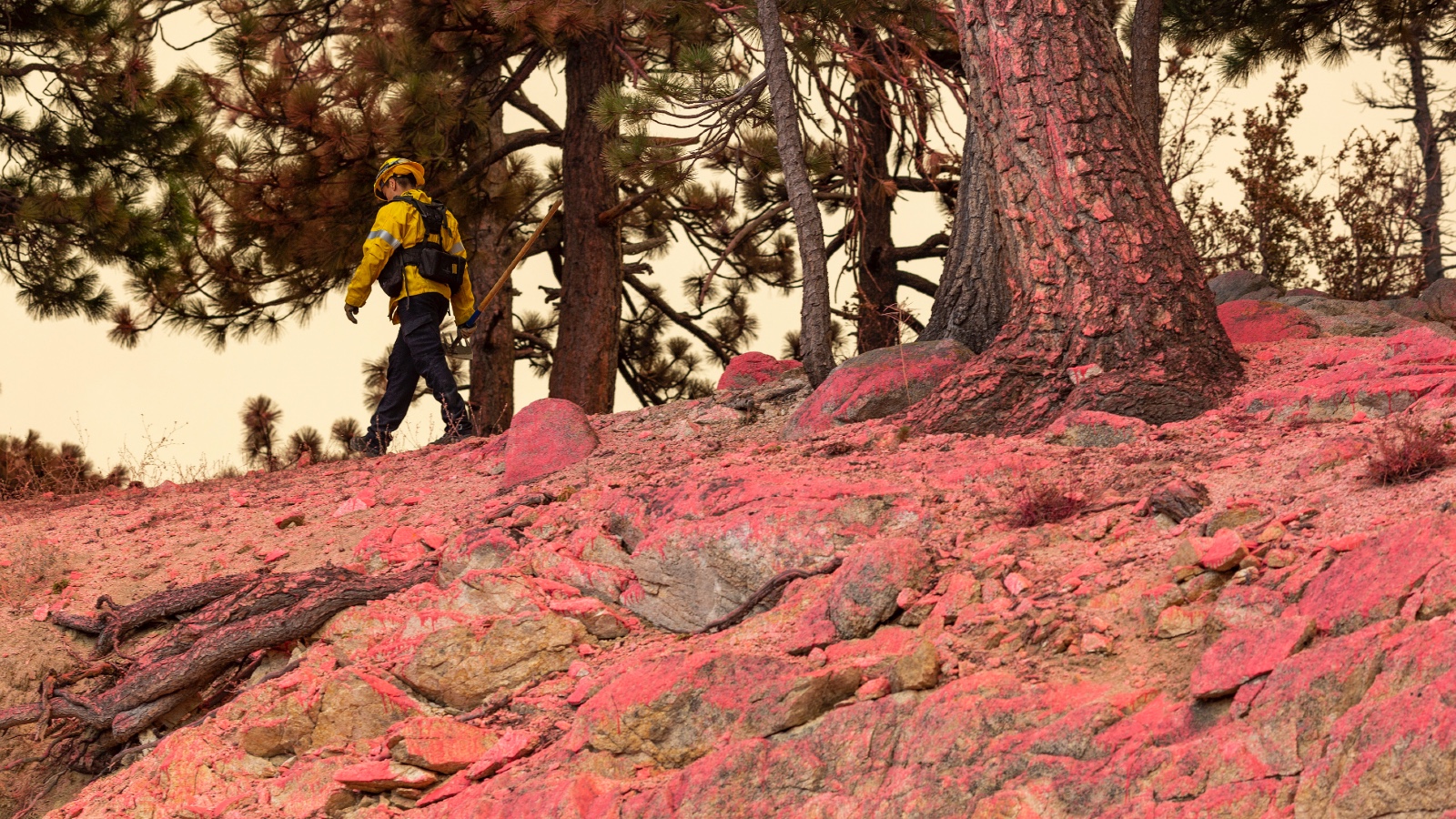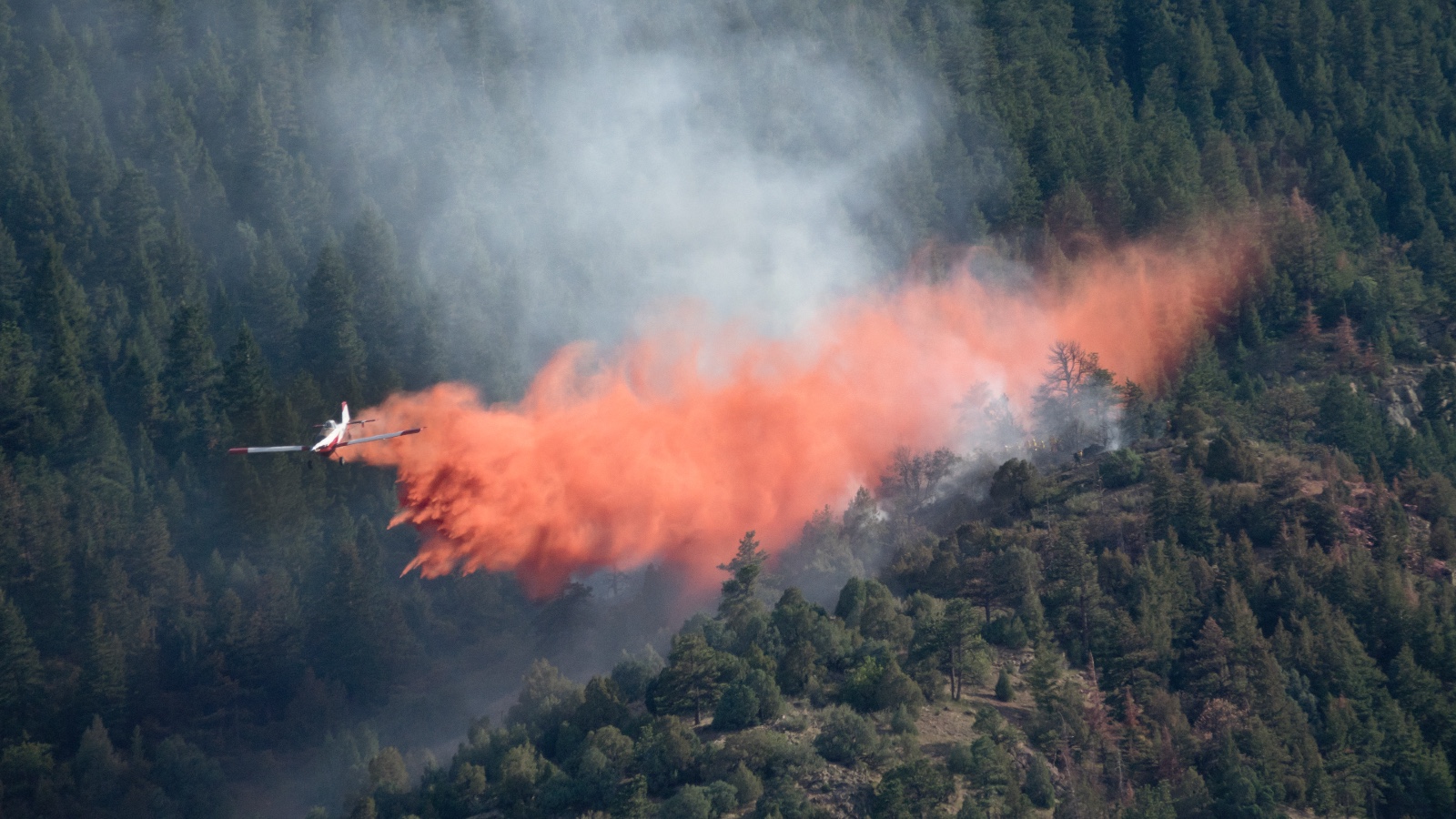Every summer, wildland firefighters across the West gear up for a monumental task, aiming to stop fires that are burning hotter and moving faster with climate change. They accomplish this in two ways: on the ground and out of the sky. From above, helicopters sling buckets of water, while airplanes dump fire retardant — a thick red solution made mostly of fertilizer. The United States Forest Service uses millions of gallons of retardant each year.
But there have long been concerns about what happens when that mix of ammonium phosphate, emulsifiers, and colorants finds its way into water. Some environmentalists worry spraying the stuff on forests does more harm than good. The main chemical in retardant — ammonium phosphate — is known to poison fish and other aquatic life, including vulnerable species like Chinook salmon. Some research suggests the slurry also could spur the growth of weeds that threaten native plants. Now, Forest Service Employees for Environmental Ethics — a nonprofit that represents current and former Forest Service employees — is suing the Forest Service over its use. They allege that the federal agency has been violating the Clean Water Act by dumping the flame-stopping chemicals into waterways.
For firefighters and some foresters, the lawsuit presents its own threat. Curbing use of fire retardants would “have a catastrophic effect on California’s ability to protect communities and infrastructure,” said Ken Pimlott, former director of Cal Fire, the country’s second biggest retardant-sprayer after the Forest Service. More than half the retardant in the country is dumped in California, where a record 4.3 million acres burned in 2020. “I don’t think people fully understand the implications” of the lawsuit, Pimlott said.
As climate change fuels more intense wildfires and threatens more people and property across the West, the lawsuit has exposed a tension between stemming those blazes and protecting lakes and streams. The Forest Service’s defenders — including city officials from Paradise, California, where a 2018 wildfire killed 85 people — say a ruling against the agency could risk lives, houses, and critical infrastructure in a region where a third of the population is vulnerable to wildfires. Critics argue that a decision in the agency’s favor could enable more pollution, continued harm to fish, and further violations of federal clean water law. Dana Christensen, a U.S. district judge in Montana, heard oral arguments in the case last month. He could rule any day.
Firefighters use retardants mostly in the West, where the area charred by wildfires has doubled in the past four decades. Across the region, grasslands and forests are drying out as temperatures rise — about half the West’s increase in aridity has been linked to human-caused warming. Fires are starting earlier, burning hotter, and lasting longer. Nationwide, blazes in the past two decades have been on average four times larger and three times more frequent than in the two decades prior. At the same time, more people are moving into rural, fire-prone areas: The number of structures destroyed by western wildfires has tripled over the past 20 years.
“That’s a web of a combination that’s causing a heck of a lot of problems,” said Daniel Leavell, a longtime firefighter and fire specialist at Oregon State University.
As fire season gets worse, retardants become more important, the Forest Service has argued in court. Fire engines and hotshots aren’t enough to fight the most intense fires, especially in remote places, which aircrafts dumping water and retardant can reach more quickly, said Alex Robertson, the Forest Service’s director of fire and aviation for Oregon, Washington, and Alaska, in a court filing.

That year, the Forest Service poured 52 million gallons of fire retardant onto forests and shrubland across the country. Air tankers, which can hold 8,000 gallons of retardant, usually use it as a line of defense instead of water, which is primarily poured directly onto flames. Firefighters paint a line of the retardant where they anticipate a fire is headed, aiming to slow fires by carpeting and cooling plants prone to combustion.
During a record fire season in the Pacific Northwest in 2021, “the use of fire retardant became a game changer” because it bought time for ground crews, Robertson said.
But retardant also winds up in waterways, where it can have deleterious effects. In 2002, a Forest Service plane accidentally dropped roughly 2,000 gallons of it into the Fall River near Bend, Oregon, killing almost all the fish — some 20,000 — along a four-mile stretch. Although a chemical, sodium ferrocyanide, that’s no longer used by the Forest Service was reportedly to blame for that disaster, there are still environmental concerns over the stuff the agency uses today. The solution, not to be confused with the PFAS-laden foam that has contaminated drinking water across the country, is mainly water, but about 10 percent ammonium phosphate and 5 percent a secretive blend of thickeners, which help it stick to plants, and dyes, which make it visible to fire crews. Ammonia is considered the most toxic component of the slurry; it can cause internal organ damage in fish. In 2009, about 50 endangered steelhead trout washed up near Santa Barbara, California with ammonium levels 100 times higher than normal after nearby fire retardant use.
Concerned about such pollution, Forest Service Employees for Environmental Ethics has sued the Forest Service twice before over its use of retardant, making the current case the group’s third retardant-related lawsuit against the agency. After each of those lawsuits, the U.S. District Court in Montana held that the federal government had violated the National Environmental Policy Act and the Endangered Species Act by failing to properly assess the environmental consequences of aerial fire retardant. Following the second lawsuit, in 2011, the Forest Service said it would mandate that airplanes avoid dumping retardant within 300 feet of lakes, rivers, and streams, unless there’s an immediate danger for human life or property.
Still, between 2012 and 2019, the Forest Service poured more than 750,000 gallons of retardant into water. “The only way to prevent accidental discharges of retardants to waters is to prohibit its use entirely,” the Forest Service’s national fire and aviation director, Jerome Perez, said in a court filing this spring.
Earlier this year, the Forest Service asked the Environmental Protection Agency to devise a Clean Water Act permit specifically for aerial retardant use. But that process will take at least two and a half years. In the meantime, Forest Service Employees for Environmental Ethics wants the court to impose a 600-foot barrier between retardant drops and waterways — an outcome that Christensen, the judge overseeing the lawsuit, said “is probably not going to happen” because 600 feet, much as the current 300-foot rule, is a “magic number” without a clear scientific basis.
Beyond the question of pollution, a key piece of the lawsuit is whether fire retardants even work. There’s some thought that they are actually less useful now that fires are burning in drier, hotter, and windier conditions. Firefighters swear that the red slurry is effective, but Andy Stahl, director of Forest Service Employees for Environmental Ethics, doesn’t buy it. Even if the chemicals in retardants are known to slow flames in a lab, Stahl says they aren’t very good at stopping fires in the real world.
“Retardant is effective in precisely the situations where it’s not needed. It’s effective when the wind isn’t blowing,” Stahl said. “There are no homes being threatened in a lab.”
While there’s anecdotal evidence that retardants keep fires from spreading, some research backs up the skepticism (although there are few studies on the issue). There’s a correlation, for example, between a rise in the use of fire retardants and an increase in fire-caused structure damage, according to Philip Higuera, a fire ecologist at the University of Montana. That’s seemingly because under the most extreme (and increasingly common) fire conditions, “fire suppression tactics are least effective,” Higuera said in a deposition.
Aerial retardants are also ineffective on fires in dense forests, because they don’t reach the ground, University of Washington fire ecologist Susan Prichard told Northwest Public Broadcasting.
Still, firefighters say the slurry is an invaluable weapon in their arsenal. Both Pimlott and Leavell recounted seeing blazes halt at retardant lines. They acknowledged times when retardants, like water, couldn’t be used or simply didn’t slow fires. But “it can save lives and resources” if applied “in the right place at the right time,” Leavell said.
A Forest Service spokesperson declined to comment, citing the ongoing lawsuit.
In March, two House representatives from California, Doug LaMalfa, a Republican, and Jimmy Panetta, a Democrat, introduced a bill that would exempt aerial fire retardants from the Clean Water Act. The landmark clean water law, passed in 1972, wasn’t written “at a time when we were seeing catastrophic fires burning at intensities unlike we’ve ever seen,” Pimlott said. “There are trade-offs here.”



